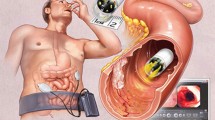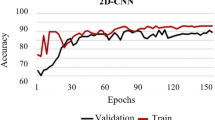Abstract
Wireless capsule endoscopy is a noninvasive wireless imaging method that has grown in popularity over the last several years. One of the efficient and effective ways for examining the gastrointestinal system is using WCE. It sends a huge number of images in a single examination cycle, making abnormality analysis and diagnosis extremely difficult and time-consuming. As a result, in this research, we provide the Expectation maximum (EM) algorithm, a revolutionary deep-learning-based segmentation approach for GI tract recognition in WCE images. DeepLap v3+ can extract a variety of features including colour, shape, and geometry, as well as SURF (speed-up robust features). Thus the Lenet 5 based classification can be made in the extracted images. The effectiveness of the performances is carried out on a publicly available Kvasir-V2 dataset, on which our proposed approach achieves 99.12% accuracy 98.79% of precision, 99.05% of recall and 98.49% of F1- score when compared to existing approaches. Effectiveness benefits are demonstrated over multiple current state-of-the-art competing techniques on all performance variables we evaluated, especially mean of Intersection Over Union (IoU), IoU for background, and IoU for the entire class.
















Similar content being viewed by others
Data availability
Not applicable.
Code availability
Not applicable.
References
Al Mamun A, Em PP, Ghosh T, Hossain MM, Hasan MG, Sadeque MG (2021) Bleeding recognition technique in wireless capsule endoscopy images using fuzzy logic and principal component analysis. Int J Electric Comput Eng (2088–8708) 11(3):11
Alam MW, Vedaei SS, Wahid KA (2020) A fluorescence-based wireless capsule endoscopy system for detecting colorectal cancer. Cancers 12(4):890
Alaskar H, Hussain A, Al-Aseem N, Liatsis P, Al-Jumeily D (2019) Application of convolutional neural networks for automated ulcer detection in wireless capsule endoscopy images. Sensors 19(6):1265
Aoki T, Yamada A, Aoyama K, Saito H, Tsuboi A, Nakada A, Niikura R, Fujishiro M, Oka S, Ishihara S, Matsuda T, Tanaka S, Koike K, Tada T (2019) Automatic detection of erosions and ulcerations in wireless capsule endoscopy images based on a deep convolutional neural network. Gastrointest Endosc 89(2):357–363
Fan S, Xu L, Fan Y, Wei K, Li L (2018) Computer-aided detection of small intestinal ulcer and erosion in wireless capsule endoscopy images. Phys Med Biol 63(16):165001
Gao Y, Lu W, Si X, Lan Y (2020) Deep model-based semi-supervised learning way for outlier detection in wireless capsule endoscopy images. IEEE Access 8:81621–81632
Ghosh T, Fattah SA, Wahid KA (2018) CHOBS: color histogram of block statistics for automatic bleeding detection in wireless capsule endoscopy video. IEEE J Transl Eng Health Med 6:1–12
He JY, Wu X, Jiang YG, Peng Q, Jain R (2018) Hookworm detection in wireless capsule endoscopy images with deep learning. IEEE Trans Image Process 27(5):2379–2392
Jain S, Seal A, Ojha A, Krejcar O, Bureš J, Tachecí I, Yazidi A (2020) Detection of abnormality in wireless capsule endoscopy images using fractal features. Comput Biol Med 127:104094
Jani KK, Srivastava S, Srivastava R (2019) Computer aided diagnosis system for ulcer detection in capsule endoscopy using optimized feature set. J Intell Fuzzy Syst 37(1):1491–1498
Jani KK, Srivastava S, Srivastava R (2021) Framework for the restoration of capsule endoscopy images using partial differential equations-based filter. IETE J Res, 1-11
Khan MA, Kadry S, Alhaisoni M, Nam Y, Zhang Y, Rajinikanth V, Sarfraz MS (2020) Computer-aided gastrointestinal diseases analysis from wireless capsule endoscopy: a framework of best features selection. IEEE Access 8:132850–132859
Lu F, Li W, Lin S, Peng C, Wang Z, Qian B, Ranjan R, Jin H, Zomaya AY (2021) Multi-scale features fusion for the detection of tiny bleeding in wireless capsule endoscopy images. ACM Transact Internet Things 3(1):1–19
Oleksy P, Januszkiewicz Ł (2020) Wireless capsule endoscope localization with phase detection algorithm and simplified human body model. Int J Electron Telecommun 66(1):45–51
Pogorelov K, Suman S, Azmadi Hussin F, Saeed Malik A, Ostroukhova O, Riegler M, Halvorsen P, Hooi Ho S, Goh KL (2019) Bleeding detection in wireless capsule endoscopy videos—color versus texture features. J Appl Clin Med Phys 20(8):141–154
Ponnusamy R (2020) Wireless capsule endoscopy image classification model to detect gastro intestinal tract diseases using visual words based on feature fusion. Int J Future Gener Commun Netw 13(1):985–998
Prasath VB, Thanh DN, Thanh LT, San NQ, Dvoenko S (2020) Human visual system consistent model for wireless capsule endoscopy image enhancement and applications. Pattern Recognition Image Anal 30(3):280–287
Rathnamala S, Jenicka S (2021) Automated bleeding detection in wireless capsule endoscopy images based on color feature extraction from Gaussian mixture model superpixels. Med Biol Eng Comput 59(4):969–987
Rustam F, Siddique MA, Siddiqui HUR, Ullah S, Mehmood A, Ashraf I, Choi GS (2021) Wireless capsule endoscopy bleeding images classification using CNN based model. IEEE Access 9:33675–33688
Saito H, Aoki T, Aoyama K, Kato Y, Tsuboi A, Yamada A, Fujishiro M, Oka S, Ishihara S, Matsuda T, Nakahori M, Tanaka S, Koike K, Tada T (2020) Automatic detection and classification of protruding lesions in wireless capsule endoscopy images based on a deep convolutional neural network. Gastrointest Endosc 92(1):144–151
Shrivastava A, Chaudhary A, Kulshreshtha D, Singh VP, Srivastava R (2017) Automated digital mammogram segmentation using dispersed region growing and sliding window algorithm. In: 2017 2nd international conference on image, vision and computing (ICIVC). IEEE, pp 366–370
Singh NP, Singh VP (2020) Efficient segmentation and registration of retinal image using Gumble probability distribution and BRISK feature. Traitement du Signal 37(5):855–864
Sivakumar P, Kumar BM (2019) A novel method to detect bleeding frame and region in wireless capsule endoscopy video. Clust Comput 22(5):12219–12225
Sornapudi S, Meng F, Yi S (2019) Region-based automated localization of colonoscopy and wireless capsule endoscopy polyps. Appl Sci 9(12):2404
Souaidi M, Abdelouahed AA, El Ansari M (2019) Multi-scale completed local binary patterns for ulcer detection in wireless capsule endoscopy images. Multimed Tools Appl 78(10):13091–13108
Wang S, Xing Y, Zhang L, Gao H, Zhang H (2019) A systematic evaluation and optimization of automatic detection of ulcers in wireless capsule endoscopy on a large dataset using deep convolutional neural networks. Phys Med Biol 64(23):235014
Wang S, Xing Y, Zhang L, Gao H, Zhang H (2019) Deep convolutional neural network for ulcer recognition in wireless capsule endoscopy: experimental feasibility and optimization. Computation Math Methods Med 2019:1–14
Acknowledgements
We declare that this manuscript is original, has not been published before, and is not currently being considered for publication elsewhere.
Author information
Authors and Affiliations
Contributions
The author confirms sole responsibility for the following: study conception and design, data collection, analysis and interpretation of results, and manuscript preparation.
Corresponding authors
Ethics declarations
Ethics approval
This material is the authors’ own original work, which has not been previously published elsewhere. The paper reflects the authors’ own research and analysis in a truthful and complete manner.
Conflict of interests
The authors declare that they have no known competing financial interests or personal relationships that could have appeared to influence the work reported in this paper.
Additional information
Publisher’s note
Springer Nature remains neutral with regard to jurisdictional claims in published maps and institutional affiliations.
Rights and permissions
Springer Nature or its licensor (e.g. a society or other partner) holds exclusive rights to this article under a publishing agreement with the author(s) or other rightsholder(s); author self-archiving of the accepted manuscript version of this article is solely governed by the terms of such publishing agreement and applicable law.
About this article
Cite this article
Padmavathi, P., Harikiran, J. & Vijaya, J. Effective deep learning based segmentation and classification in wireless capsule endoscopy images. Multimed Tools Appl 82, 47109–47133 (2023). https://doi.org/10.1007/s11042-023-14621-9
Received:
Revised:
Accepted:
Published:
Issue Date:
DOI: https://doi.org/10.1007/s11042-023-14621-9




